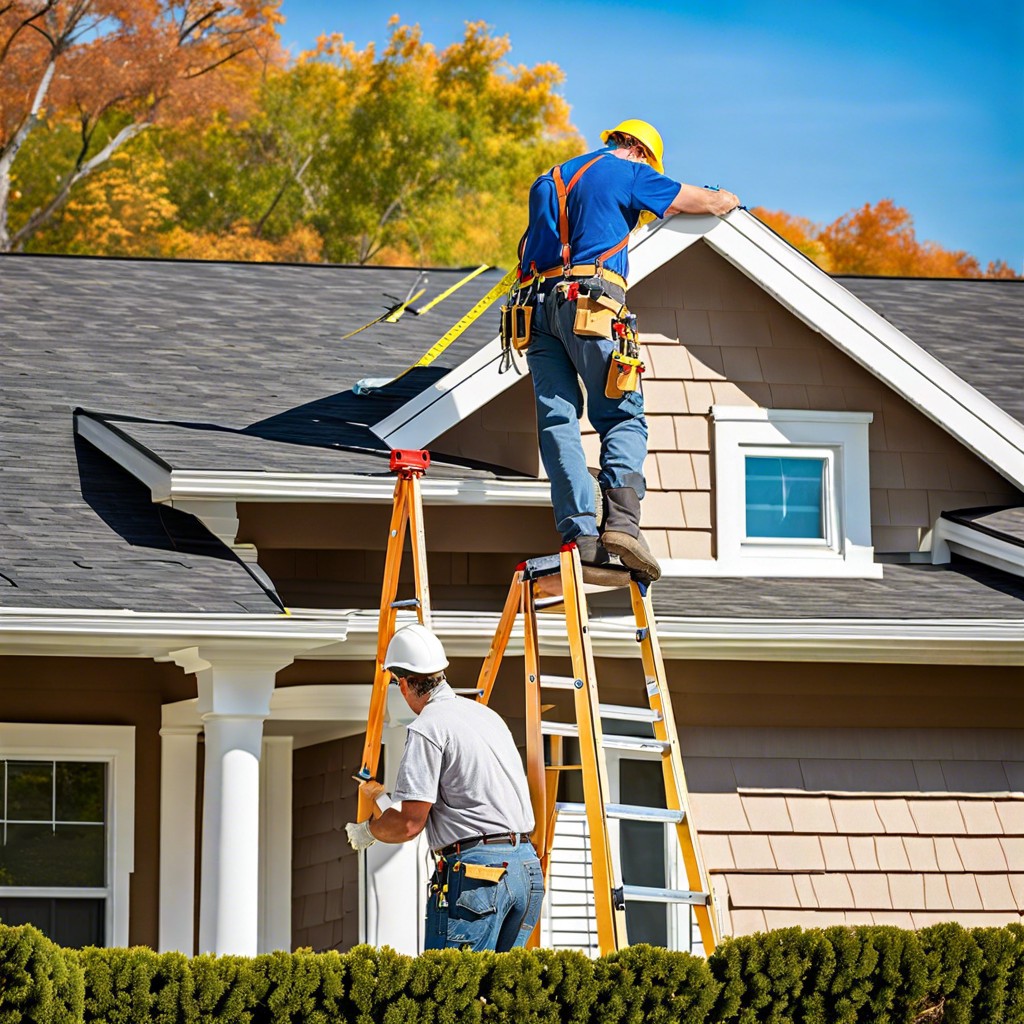Last updated on
In this comprehensive guide, you will learn the methodical steps necessary to accurately measure a roof for shingles.
Key takeaways:
- Accurate measurements prevent waste and ensure budget control.
- Essential tools include ladder, tape measure, clipboard, and paper.
- Calculate roof area, adjust for slope, and consider waste allowance.
- Professionals offer expertise, DIY saves cost but requires precision.
- Calculate shingles by dividing total square footage by 100.
Why Accuracy Matters

Accurate measurements ensure the purchase of the correct quantity of roofing materials. Excess materials waste money, while a shortfall can delay the project and lead to color mismatches with additional batches.
Precision averts unnecessary waste, contributing to environmental sustainability. It also enables reliable budgeting and cost control, ensuring the roofing project stays within financial constraints.
Lastly, accuracy in measuring anticipates the correct allocation of labor, helping to streamline the project timeline and optimize workforce efficiency.
Tools Required and Safety Considerations
Before embarking on roof measurements, assemble the right tools to ensure accuracy and safety.
A sturdy ladder is essential for secure access to the roof. Confirm that the ladder is suitable for your weight and the height of your building.
A tape measure is your primary tool for recording the length and width of the roof. Opt for a long, durable tape measure that can withstand outdoor use.
A clipboard and paper or a digital device with a note-taking app will be necessary to record measurements. Remember to bring writing tools that can handle being used outdoors, like pencils or all-weather pens.
For complex roof structures, a measuring wheel or a laser distance measurer can improve efficiency and precision. These are optional but can be helpful in reducing measurement errors.
Wear appropriate footwear with good traction to minimize slips and falls. Non-slip boots are recommended.
Safety harnesses and roofing anchors should be considered, especially for steep roofs.
If measuring from the ground, binoculars can assist in estimating dimensions and inspecting the roof safely. A drone can also be utilized for overhead imaging and measurement, providing a modern alternative to traditional methods.
Always have a partner nearby to spot you while working at heights. Never attempt roof measurements alone.
Safety glasses and a hard hat can provide added protection against falling debris or accidental impacts while on the job.
Given the inherent risks of working at height, prioritize safety over speed. It is better to measure twice and climb once, ensuring accuracy while preserving well-being.
Step-by-Step Roof Measurement and Calculation Process
Begin by measuring the length and width of each plane of the roof (including dormers) in feet. Calculate the area of each plane by multiplying the length by the width.
Account for the slope of the roof by determining the pitch, which is the roof’s vertical rise over a 12-inch horizontal span. For accuracy, use a pitch gauge or smartphone app. Multiply the area of each plane by the corresponding pitch factor to adjust for slope.
Add the area of each plane together to get the total square footage of the roof.
Roofing materials are commonly sold by the square, with one square covering 100 square feet. Divide the total square footage of the roof by 100 to determine the number of squares needed.
Consider adding 10-15% to the total to account for waste and overage, especially for roofs with many hips, valleys, or dormers.
To estimate the number of bundles of shingles needed, check the coverage for the specific shingle product chosen, generally, three bundles equal one square.
Record all numbers during the process and double-check calculations to ensure accuracy before purchasing materials.
Professional Vs. DIY Roof Measurement for Shingles
Deciding between a professional assessment or a do-it-yourself approach largely depends on individual comfort with heights, experience, and the complexity of the roof.
When accuracy is crucial, especially for unique or intricate roofs, professionals bring expertise and advanced tools to the task. They understand the subtleties of roof features, such as valleys and dormers, which may not be apparent to the DIY’er. Additionally, they can offer insights into underlying roof issues that a homeowner might overlook during their own evaluation.
On the other hand, opting to measure the roof yourself can be cost-effective and informative. It allows for a personal verification of the needed materials and can be a valuable learning experience. Remember that a precise calculation is necessary to avoid under or over-ordering shingles, which can impact both project cost and timeline.
Regardless of your choice, emphasize safety and accuracy. A misstep in measurements or physical misjudgment could lead to ordering the wrong material quantity or, worse, personal injury. Consider the factors at play, and weigh the value of professional input against the satisfaction and potential savings of a well-executed DIY project.
FAQ
How do you calculate shingles for a roof?
To calculate the number of shingles for a roof, first determine the total square footage of the roof, divide it by 100 to find the number of roofing squares, round up for any fraction, and then multiply by three since a bundle of shingles typically covers one-third of a roofing square.
How many bundles of shingles do I need calculator?
To estimate the number of bundles of shingles needed for your roofing project, simply multiply the total square footage of your roof by 0.03.
What is the formula for measuring a roof?
The formula for measuring a roof is attained by multiplying the length of your house by its width to get the area, which is then multiplied by your roof’s pitch.
How many square feet does a bundle of shingles cover?
A bundle of shingles typically covers 33 square feet.
How much allowance should be made for roof overhangs in shingle calculation?
In shingle calculation, an allowance of an extra 10% should be made for roof overhangs.
What factors should be considered when estimating shingle waste?
When estimating shingle waste, factors to consider include the roof’s size, pitch, and complexity, including valleys, hips, and other features, as well as the type of shingles used and the cutting wastage.
How does the roof pitch affect the shingle quantity required?
The roof pitch impacts the quantity of shingles required as steeper roofs demand more shingles due to their larger surface area compared to less inclined roofs.





